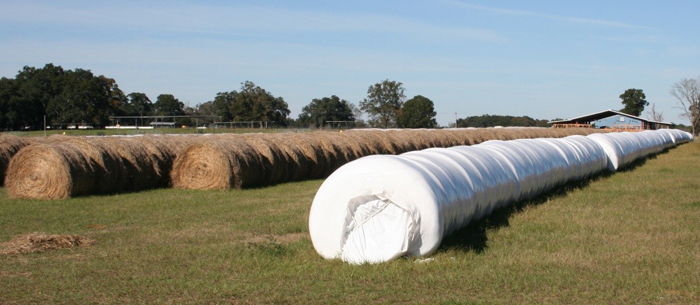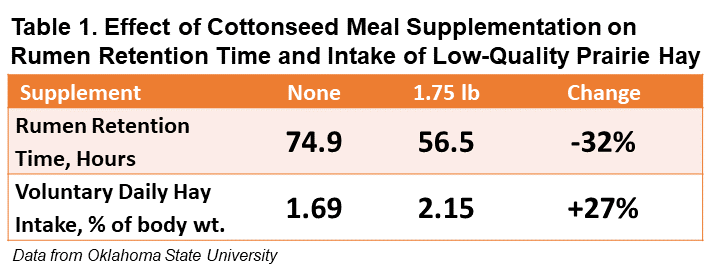
Hay and baleage stored for winter feeding at the UF/IFAS NFREC Beef Unit near Marianna. Photo: Nicolas DiLorenzo
Glenn Selk, Oklahoma State University Emeritus Extension Animal Scientist
As you drive around this fall you see many big round bales of hay stored for winter feed. The quality of this hay will vary a great deal. Frankly, some of it will be low in protein content and therefore low in digestibility. The microorganisms in the rumen of beef cows and replacement heifers require readily available protein to multiply and exist in large enough quantities to digest the cellulose in low quality roughages. Protein supplementation of low-quality, low protein forages results in a “positive associative effect.” This “positive associative effect” occurs as supplemental protein available to the “bugs” in the rumen allows them to grow, multiply, and digest the forage more completely and more rapidly. Therefore the cow gets more out of the hay she consumes, she digests it more quickly and is ready to eat more hay in a shorter period of time. Data from Oklahoma State University illustrates this (Table 1). The prairie hay used in this study was less than 5% crude protein. When the ration was supplemented daily with 1.75 lbs of cottonseed meal (41% crude protein), retention time of the forage was reduced 32% which resulted in an increase in feed intake of 27%. Because hay intake was increased, the animal had a better chance of meeting both the protein and energy requirement without supplementing other feeds. Because retention time was decreased, one could postulate the protein supplementation in this situation also increased digestibility of the hay.
 As producers prepare their winter supplement strategies, they can see the importance of providing enough protein in the diet of the cows to feed the “bugs” in the rumen. If the hay is low in protein (less than 8 % crude protein), a small amount of supplemental protein such as cottonseed meal, soybean meal, or one of the higher protein by-product feeds, could increase the amount and digestibility of the hay being fed.
As producers prepare their winter supplement strategies, they can see the importance of providing enough protein in the diet of the cows to feed the “bugs” in the rumen. If the hay is low in protein (less than 8 % crude protein), a small amount of supplemental protein such as cottonseed meal, soybean meal, or one of the higher protein by-product feeds, could increase the amount and digestibility of the hay being fed.
This strategy requires that ample forage is available to take advantage of the “positive associative effect.” As the table above illustrates, properly supplemented cows, or replacement heifers, will voluntarily consume about 27% more hay, if they were provided adequate protein. As long as enough forage is available, this is the positive effect of a small amount of protein supplementation.
